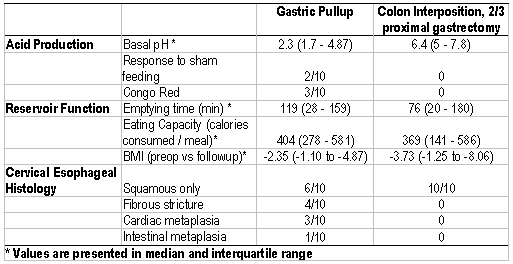# 102686 Abstract ID: 102686 A Gastric Pullup Has Similar Function but More Cervical Esophageal Injury Than a Colon Interposition after Esophagectomy.
Farzaneh Banki, Tom Demeester, Jeffrey A Hagen, Jeffrey H Peters, Steven Demeester, LOS ANGELES, CA
Introduction: Reconstructive options following esophagectomy include gastric pullup and colon interposition. The relative functional outcome of each of these reconstructive techniques has been subject of much debate. Objective: To compare the long term functional outcome after esophageal reconstruction with either stomach or colon. Methods: The study population consisted of 20 randomly selected patients who had an esophagogastrectomy: 10 reconstructed with a gastric pullup to the cervical esophagus and 10 with a colon interposition between the cervical esophagus and the distal third of the stomach. Median follow up was 47 months, range (14-72) for the gastric pullup group and 29 months (6-65) for the colon interposition group. Acid production was evaluated by basal gastric pH, response to sham feeding and detection of gastric mucosal acidification with Congo red solution. Alimentation was assessed by a symptom questionnaire. Reservoir function was measured by emptying time (Technetium scan),calories consumed during a test meal and postoperative changes in body mass index (BMI) in kg/m2. Histological changes in the remnant cervical esophagus were evaluated by 4 quadrant biopsies. A fibrous stricture was defined as endoscopic fibrous ring that developed 6 months or more after the procedure and required dilatation. Results: Alimentation and reservoir function were similar following gastric pullup and colon interposition. Patients with gastric pullup had higher acid production (p=0.006) and more mucosal injury. Conclusion: Reconstruction with gastric pullup maintains acid production and leads to mucosal injury in the cervical esophagus with potential risk for carcinoma.

|
 500 Cummings Center
500 Cummings Center +1 978-927-8330
+1 978-927-8330
 +1 978-524-0461
+1 978-524-0461